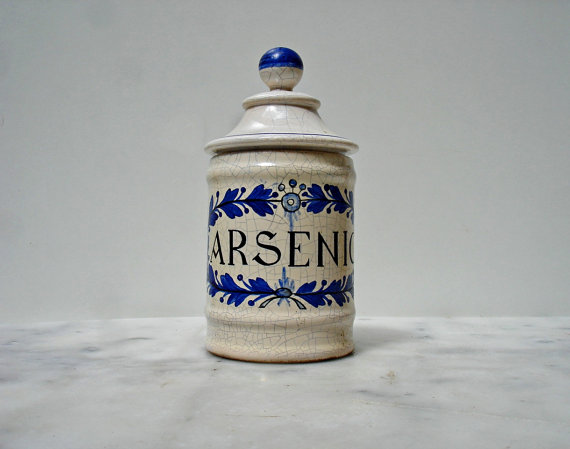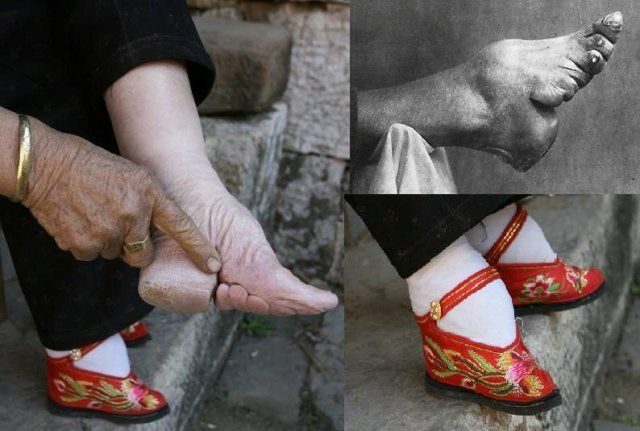People have suffered for beauty since ancient times. The ancient Egyptians wore dark eye make-up—udju and mesdemet or kohl—which contained harmful copper and lead. The ancient Greeks and Romans spread pungent crocodile dung on their faces and mixed it into their baths. Animal poop facials are still popular today, especially in Japan. Historically, putrid smells, severe damage to the body, and obvious risks have been accepted for beautifying benefits.
10. Arsenic Consumption

While arsenic has frequently been used to commit murder
Some of the toxicophagi could swallow enough arsenic to kill the average person, and still appear to be good health. Withdrawal could cause vomiting, constipation, spasmodic pain, and other problems. People around the world adopted the beauty practice anyway. Its mention in James Johnston’s The Chemistry of Common Life likely contributed to its popularity as a cosmetic implement. The arsenic eaters either weaned themselves off gradually or died unexpectedly due to arsenic-related complications.
9. X-rays for Hair Removal

Wilhelm Roentgen discovered x-rays in 1895. Dr. Leopold Freund of Austria observed that x-rays made people’s hair fall out and recommended it as a treatment for hypertrichosis. Dr. Albert Geyser embraced the treatment enthusiastically. He lost the fingers on his left hand to radiation damage. Geyser created the Cornell tube, which use “ultrasoft” x-rays. He and his son later founded Tricho Sales Corporation.
In a 1915 article, Dr. Geyser claimed that the Cornell tube required “no protection of any kind, either for patient or operator.” He leased x-ray machines to beauty shops and trained operators to handle The Tricho System. Sessions were called ‘light treatment’ or ‘short-wave treatment.’
The long-term effects of Cornell tube treatments eventually became clear. Patients’ skin wrinkled and thickened from radiation exposure. They developed skin lesions, ulcers, and cancer. The x-ray hair removal clinics functioned into the mid-century. The government didn’t take action as would be expected nowadays. Instead, personal horror stories published in newspapers spread awareness and cut off demand for the service.
8. Rat-Infested Wigs

Voluminous wigs became insanely popular in the 1800s. The more elaborate a wig, the more impressive the wearer’s beauty. Royalty flaunted their status with flamboyant clothes and snazzy hair. There came a point at which lard was required to secure the wigs; they were simply too large to stand on their own.
These hairpieces were attached to genuine hair and worn for weeks at a time. The lard wasn’t washed out, so it attracted lice and dangerous rodents. Some women slept with cages around their wig to keep the creepy creatures out. However, not everyone owned a hair cage. Rats occasionally penetrated and nested in these wigs.
In France, at the beginning of the 19th century, men’s wigs were more intricate than women’s. By the late 1800s, women were sporting hairpieces that towered a foot or higher above their heads. The weight sometimes caused inflammation around the temples.
7. Tapeworms in the Tummy

During the Victorian era, in the early 1900s, advertisers marketed pills that contained beef tapeworm cysts. Tapeworms would devour what the host ate, and the host would lose plenty of weight. Tapeworms may reach up to 30 feet long, though, and cause problems from headaches to dementia. Diarrhea and vomiting are also to be expected. An anti-parasitic pill was used to force the tapeworm out—often a more complicated process than might be imagined.
As it turns out, the tapeworm diet of the early 20th century may be a rumor. Its legitimacy is still debated today. The advertisements certainly existed, but we can’t scientifically verify the content of the pills. More recently, however, a woman in Iowa swallowed a tapeworm to lose weight. She reportedly bought it over the internet. Websites are promoting the tapeworm diet in the modern day. One tapeworm won’t make much of a difference, but that single worm can reproduce in the body, leading to both weight loss and serious health issues.
6. Lead Foundation

The history of lead foundation dates back to the Greek and Roman empires. Lead was also used in items from pipes to drinking vessels. Lead poisoning was likely widespread and contributed to the low birth rate. Let’s fast forward to the 1500s. Women of the Elizabethan era combined lead with vinegar to create ‘Venetian ceruse’ or ‘Spirits of Saturn’. A white complexion was highly sought-after, as it was considered the height of beauty. They applied egg whites to add shine. Even as recently as the 1900s, Japanese and Chinese infants regularly died from ingesting cosmetic lead worn by their mothers.
Lead is absorbed through the skin. Poisoning may cause hair loss, weight loss, pain, brain damage, organ damage, paralysis, and a variety of other symptoms. When used in foundation, lead causes skin to wrinkle and scar. Historically, this problem was remedied by applying more poisonous foundation to cover the damage.
5. Belladonna Drops

Atropa belladonna, also known as ‘deadly nightshade,’ is extremely toxic. In Greek mythology, Atropos was one of the three fates—the one who cut the thread of life. Belladonna been taken as a hallucinogen, as medicine, and as poison. It was also added to eye-drops for its dilating effects. Belladonna contains a natural muscle relaxant that Venetians greatly appreciated. The name ‘belladonna’ is an homage to the Italian Renaissance women who famously used it.
Large pupils were considered attractive, but that beauty came at a cost. Belladonna elevated heart rate and blurred vision. Women who used it too much went blind. Many other beauty products throughout have had the same effect. In 1933, Lash Lure Eyelash and Brow Dye caused 15 recorded cases of permanent blindness. The product contained 30 times the recommended amount of paraphenylenediamine.
4. Foot Binding

Chinese foot binding is estimated to have begun in the 10th century, during the Song Dynasty. Women’s feet were broken with their toes were bent inward. At first, foot binding was a sign of high social status, reserved for women who didn’t have to work. Bound feet also showed that a potential wife would be submissive. This painful, severely disfiguring custom spread to the lower classes over time. It was finally banned in 1911, but still continued in rural areas.
The binding process began when a child was 5 or 6 years old. Smaller feet indicated higher refinement, which improved a woman’s marriagability. A three-inch foot, or “golden lotus,” was ideal. Anyone who wound up with feet that were five inches or longer (i.e., iron lotuses) would have significantly fewer marriage prospects. The ‘lotus feet’ tradition lasted through a millennium.
3. Corsets

Corsets were bodywear that could be tightened to reshape the torso. Corset-created 13-inch waists were never the norm, but women did use corsets to squeeze their bodies many inches inward, causing negative effects on health. The pressure led to constipation and organ damage. Shallow breath caused dizziness and fainting. Women’s back muscles were also weakened by regular use.
Corset wearing has continued into the modern day. Waist training, also known as tight-lacing, is advertised as a way to shape the body; to flatten the stomach while maintaining desirable curves elsewhere. Some pros recommend women pair waist training with diet and exercise for the best results. Others recommend avoiding corsets altogether. Spanx are a type of modern-day corset, and they compress the body enough to cause nerve problems, stomach pain, and other bodily issues affected women who wore whalebone corsets not so long ago.
2. “Toebesity” surgery

Something of a new phenomenon, toe-besity surgery beautifies “fat feet.” It allows people have more confidence as they wear sandals and show off their piggly wigglies. It also allows some to fit into high heels or other shoes that don’t conform to their natural foot shape. Surgery to shave toe fat and bone would have been considered ludicrous at the turn of the century, but this cosmetic procedure has been gaining traction over the last decade.
According to the American Podiatric Medical Association, foot surgery is usually performed out of necessity. People who elect to have any medically unwarranted procedure put themselves at risk. The dangers of surgery include infection, a negative reaction to anesthesia, unsatisfactory results, pain, and the unexpected need for more surgery in the future.
1. Breast Augmentation

The first silicone breasts were implanted Houston, Texas in 1962. Now breast augmentation is the second-most popular elective cosmetic surgery performed worldwide. Countries that perform the procedure most include the United States, Brazil, Italy, and China. On top of the normal risks of surgery, breast augmentation poses other dangers. Implants may last for decades. On the other hand, they can rupture in a matter of weeks, in which case another full-cost surgery is required.
Women who have breast implant surgery may develop breast tissue atrophy, unpleasant changes in breast sensitivity, or scar tissue that causes pain. Asymmetry, unexpected deformities, and generally disappointing results are not uncommon. Breast implants have also been linked to cancer in rare cases. Those aren’t even close to all of the painful possibilities, but potential problems are often ignored in favor of a little extra bulk in the bra. Is it really that unusual? Clearly, people have been compromising their health for beauty for thousands of years.
1 Comment
“Atropa belladonna, also known as ‘deadly nightshade,’ is extremely toxic.”
Wow who knew deadly nightshade would be extremely toxic?